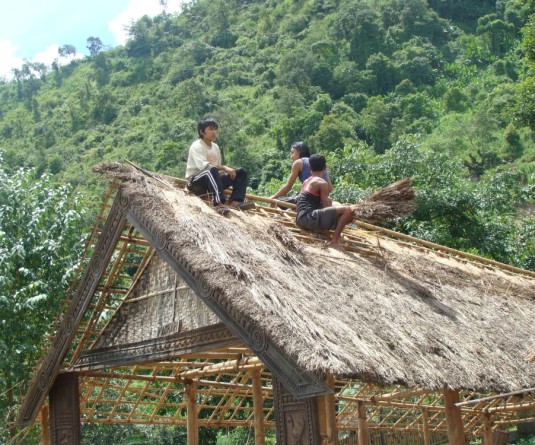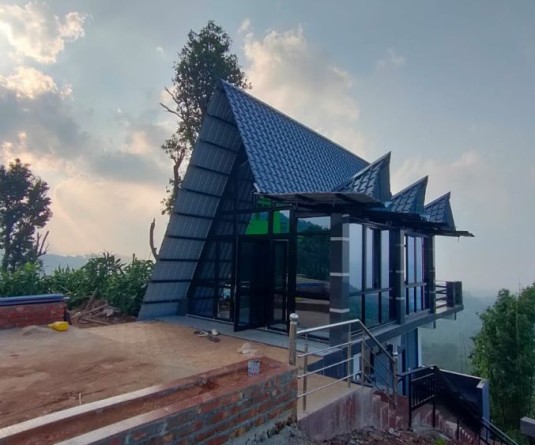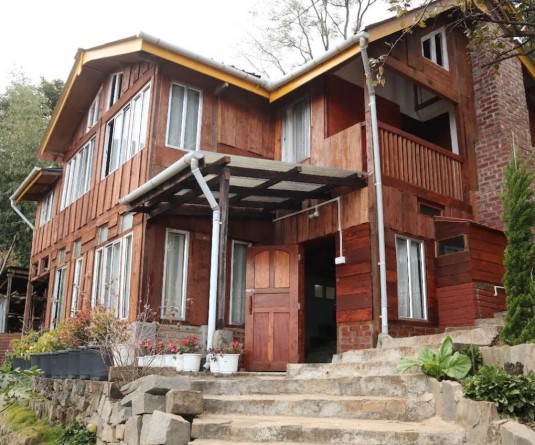A young woman weaves a makhela in Longwa. The machine is shared amongst a group of women, so they visit other’s houses to continue the work daily.

With NAIP underway, Longwa breathes with new agricultural practices and cottage industries. A promise of a better future.
Sidrah Fatma Ahmed
Longwa | June 27
Manpoh Konyak (35) is a resident of Longwa, Mon District and like many others in the village he lives by farming. For side income he has opened a shop in the village which fulfils the little needs of a village life; items like oil, rice, sweets and biscuits. It also adds a little money to Manpoh’s pocket. After all farming techniques in Longwa do not produce surplus to make income. One produces only enough to eat, and a little to trade for other household items.
In the past, Manpoh had been growing millet and maize. Last year, he was familiarized with Cardamom plantation. The practice was taught to him under a project undertaken by School of Agricultural Sciences and Rural Development, Medziphema in association with Indian Council for Agricultural Research. It is a National Agricultural Innovation Project, one of the many being run in the country. The projects encourage fast and sustainable transformation of Indian agriculture, in order to help poverty alleviation and income generation.
Since Cardamom is not a spice popular in Naga cuisine, the cultivation of it was looked upon apprehensively. Villagers were skeptical if it would generate profits at all, explains Medo, Research Associate to the project. But, slowly as its farming started benefitting lucratively, it was quickly taken up by the farmers. “Cardamom is an easy spice to cultivate. The first year I produced 27 Kgs of Cardamom. I sold every Kg for Rs. 500. This year I am expecting double or more of what I produced last year”, says Manpoh.
With the village’s successful step into Cardamom plantation, buyers from Assam directly started coming to buy the produce.
Under the NAIP project, an individual was identified from every household. Roughly, 500 locals from the village were divided into 25 Self Help Groups. Later, with the success of some, 7 more groups were put together. Every SHG was assigned one good practice researched and led by expert faculty of SASRD. Some practices include Weaving, Knitting, Tailoring, Piggery, Dairy, Bee Keeping, Poultry and Fishery. Under Horticulture, some include Mushroom, Potatoes, and Cardamom. Cultivation of Passion fruit and Orange though tried, failed to give good produce due to climatic conditions. The project is being funded by the World Bank and has been in effect at the village since September, 2007. “It was to go on for 5 years, but noticing the need of the village it’s been extended for another year”, says Prof M Aleminla Ao, Dean SASRD.
K. Phamsa, is the Secretary of the Knitting SHG. Phamsa resonates the talent and voices of many other women of Longwa. She is good at hand work. She divides her time between her household and making beaded jewelry, shawls and makhelas. She lends to the running of the household with the money she earns.
There are three knitting SHGs and each group has been provided with a knitting machine under the project. “Before the machine, we would use our hand. It would take us a week to knit a baby suit. Now it barely takes us a day. It saves a lot of our time”, says Phamsa. The money the women make out of the produce is also very wholesome. She explains the economics of it. A Kg of wool costs Rs.350. Every 1 Kg, 4 baby suits can be made. Every baby suit sells for Rs.250. A small labor price is excluded from the profit for the women, and the rest is deposited in the bank account of the SHG group. The money saved in the bank account is used to buy more wool and would later be used to buy more machines. It would aid self sustenance once the project is seized from the village.
Tonghi and Khampei two young men are part of the Fishery SHG. Under the project, a common fishery pond has been built for the villagers. The group is provided with fishlings of Common Carp, Grass Carp and Rohu to breed in the pond. Professor N Savino, SASRD taught the SHG the nuances of successful fish breeding. “We bred fish before, but on a smaller scale. After this project we learnt better practices of upkeep. For example, before putting the fishling in the pond you have to treat the pool with limestone so all insects die, otherwise the small fishling will be eaten up”, says Khampei. The fish is then sold to the villagers, and the SHG can buy the produce a cheaper rate.
The villagers are also taught how to maintain the SHG bank accounts. Every group has a chairman, a secretary and a treasurer. They insure that proper records are maintained. The positions are rotated in the groups so that everyone has an opportunity of being a leader.
In many villages in Nagaland, like Longwa the economies are perched on agriculture. The plus point is that there are no landless farmers here like in other parts of the country. It’s a head start at concentrating all the energy at teaching farmers better techniques to fully utilize their land. If the expected degree of development is attained in Longwa, such projects should be started in other villages too. With farmers earning better, it will have a direct effect on education and quality of life. In case of Longwa, there is a government school and a foreign funded missionary school. But, villagers believe quality education can be found only in Mon town. Manpoh with his successful cardamom farming in the future plans to send his son Apon, now 2 years old to a school at Mon. Other villagers also have plans like such for a brighter future for their young and a better standard of living for their families.






